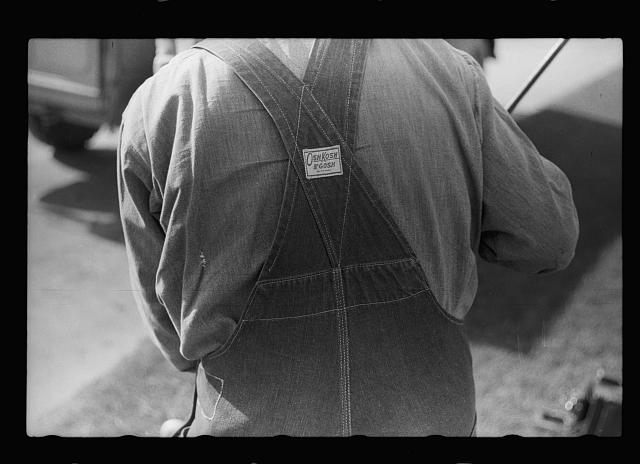The Bizarre Case of New Zealand’s Exploding Pants
Weeds. Chemicals. Fire. Trousers.

Few professionals ask more of their trousers than farmers. Their rugged, often dirty work no doubt taxes the cleanliness and durability of any garment. Perhaps the least a farmer can ask of his pants is that they don’t spontaneously burst into flames. But in the case of a number of agricultural workers in 1930s New Zealand, it turns out, that was indeed too much to ask.
Fans of Discovery’s long-running science-and-explosions show, Mythbusters, might be familiar with the strange spate of self-immolating trousers that briefly plagued New Zealand farmers in the 1930s. What’s less commonly known about this unusual saga is that it all began with a weed called ragwort.
Native to Europe, Jacobaea vulgaris, commonly known by the unattractive nickname ragwort, made its way to New Zealand in the 19th century, and quickly became more than a nuisance. Mature ragwort looks sort of like a taller dandelion, producing a bright yellow flower with long, thin petals. But the weed is also poisonous to horses and cows, making it a serious problem if it begins to gain a foothold in grazing pastures. Sheep and goats are more readily able to stomach ragwort, and often the development and spread of the weed is kept in check simply by allowing sheep to eat it. But in early 20th-century New Zealand, the ragwort situation began to get out of control.

As the scholar James Watson writes in a 2004 essay, The Significance of Mr. Richard Buckley’s Exploding Trousers: Reflections on an Aspect of Technological Change in New Zealand Dairy Farming Between the World Wars, dairy farming became more widespread in New Zealand in the first few decades of the 20th century. As this shift unfolded, more and more pasture space began to be given over to cows, and less to sheep. Since cows generally avoid ragwort (see: poison), this allowed the weed to begin spreading like, well, a weed, pushing out other beneficial grasses and plants as it did so. The growth of ragwort was so rapid and widespread that by 1930, some farmers began looking to the Department of Agriculture for answers. One of their early solutions was to use a chemical herbicide, sodium chlorate.
Inspired by a 1930 article that extolled the virtues of the toxic compound as an effective ragwort killer, the government began encouraging farmers to spray down affected areas. And sure enough, they managed to kill a ton of ragwort. But in addition to being a highly effective herbicide, sodium chlorate is also highly caustic when dry, a fact that many farmers found out only as their pants began to explode.
One of the earliest cases of exploding pants, and the one most closely associated with the phenomenon, involved a farmer named Richard Buckley, who made the local news after some of his pants exploded in his house. After wearing them to spray the sodium chlorate, he hung them in front of the fire to dry out. Out of nowhere, his trousers exploded with a bang. According to a news report from the day, he was able to snag his now flaming pants and throw them out onto the grass where small explosions continued to erupt in the garment. Buckley was alarmed, but unharmed.
Around the same time, similar reports of spontaneously combusting pants began to appear, and not all of them were as harmless as Buckley’s. One report claimed that a farmer was riding his horse when the friction caused his pants to begin to smolder right there in the saddle. Another pair of pants were hanging out to dry when they suddenly burst into flames. Then there were the unfortunate souls who happened to be wearing their pants when the chemical reaction got started. Some survived with serious burns, while at least a handful of farmers died from the ignitions. One person, referenced in Watson’s paper, died after lighting a match in his electricity-free home, just trying to check on his baby.
The problem was that in order to apply the sodium chlorate, the chemical was mixed with water to create a solution, which was then sprayed and spread, getting all over the pants of the farmers using it. As the clothing dried, the water was removed, leaving nothing but volatile sodium chlorate crystals bonded to the fibers. In essence, it created explosive cloth that could be set off by flames, heat, or even just a strong impact.
Luckily New Zealand’s exploding pants epidemic didn’t last long, quickly becoming an odd historical footnote after use of the dangerous chemical slowed. It remained in the cultural consciousness thanks to local legend and records like Watson’s essays, and that episode of Mythbusters. It even became the titular case for New Scientist’s 2011 collection of odd tales of accidental science, Farmer Buckley’s Exploding Trousers and Other Odd Events On the Way to Scientific Discovery.
Ragwort remains a noxious weed found all across New Zealand. A number of other attempts have been made to control the plant, including the use of further herbicides, as well as introducing biological controls such as the ragwort flea beetle and the cinnabar moth (which was actually introduced in 1926). Thankfully, none of these have caused anyone’s pants to explode.









Follow us on Twitter to get the latest on the world's hidden wonders.
Like us on Facebook to get the latest on the world's hidden wonders.
Follow us on Twitter Like us on Facebook